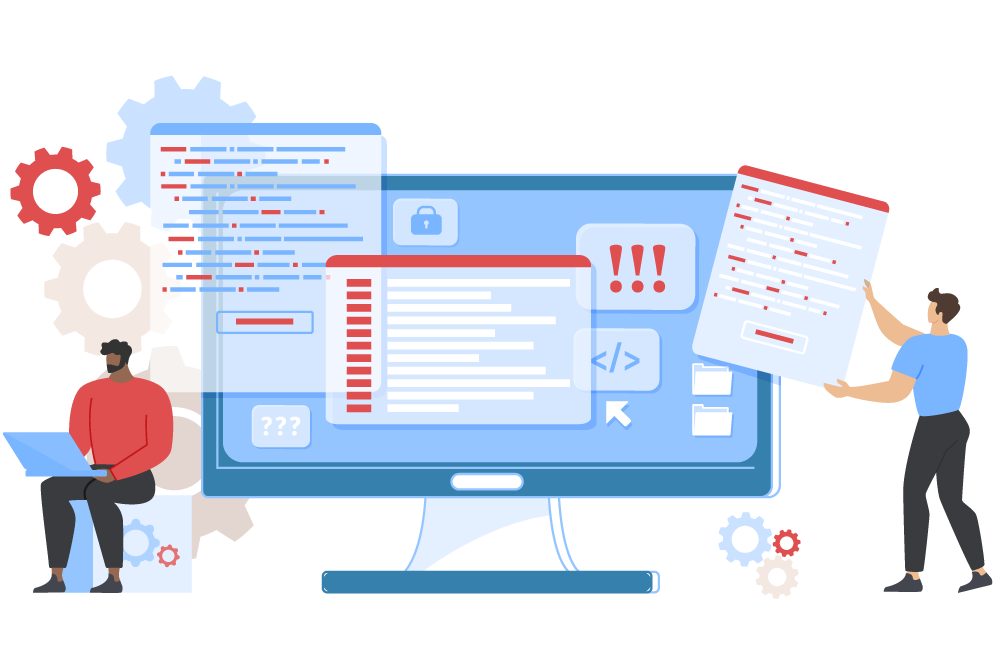Recommended Ideas To Selecting application development with Low-code platforms
Recommended Ideas To Selecting application development with Low-code platforms
Blog Article
Benefits Of Developing Applications Using Low-Code In Terms Of Integration Capabilities
Low-code integration of applications has many advantages, including the ability to seamlessly integrate with various applications and systems. Here are a few principal benefits: APIs and connectors that are pre-built.
A Wide Range of Connectors : Low-code platforms generally come with a huge library of prebuilt connectors to popular enterprise systems (e.g. ERP CRM, databases as well as cloud-based services). This makes it easier for connecting these systems.
API Integration: Many platforms offer out-of-the box API integration capabilities. This allows developers to easily connect with external data and services.
Ease of Use:
Drag-and-Drop Integration integration tasks can usually be done using drag-and drop interfaces, making it possible for both developers and non-developers to design complex integrations without writing extensive code.
Visual Workflow Designers: These software tools aid you in understanding and configuring integrations with more ease.
Standardized Integration Methods:
SOAP and RESTful Services Support for web service protocols like SOAP and REST allows for straightforward integration with a wide range of other software and systems.
OData Standards: OData standards permit the simple manipulation and accessibility of data across various platforms and apps.
Real-Time Data Synchronization:
Low-code platforms enable real-time integrations between systems and applications. This allows information to be updated and consistent across all departments of the company.
Event-Driven architecture: Certain platforms can support event-driven architectures. This lets applications react to events in real-time that is vital for interactive and dynamic apps.
Legacy System Integration:
Low-code platforms: These can be used to connect older systems to modern systems. They are a great way to modernize your IT infrastructure, without having to redesign everything.
Data Migration Tools Data Migration Tools facilitate the transfer of data from old systems to new applications built using low-code platforms.
Third-Party Services Integration:
Cloud Services: Seamless Integration with Cloud Services such as AWS Azure Google Cloud and Google Cloud makes it easy to deploy applications.
Business Applications Integration: Low-code platforms can be integrated with different business software like Salesforce, SAP and Microsoft Dynamics. This creates a seamless workflow between business processes.
Simplified management of data:
Unified Data Models: Some low-code platforms provide unification of data models, which simplify data management and integration across different systems.
Data Connectors - Pre-configured connectors which provide easy access to, and manipulation of, data from a variety of sources.
Security and Compliance:
Low-code integration platforms comply with security standards to safeguard information while it is in transit or at rest.
Security Features: These platform usually have features to ensure that the integrations meet regulations, for example GDPR and HIPAA. This gives peace of mind for businesses that handle sensitive information.
Extensibility:
Custom Code and Scripts: Low-code platforms can often be able to handle more complicated integrations by allowing the inclusion of custom scripts and codes. This allows flexibility without compromising the ease of use.
Plug-in Ecosystems. A community of plug-ins and extensions will allow you to enhance your capabilities of integration, while adding additional functions as needed.
Overall, the low-code platform's capabilities for integration make it a powerful instrument to create interconnected applications which are scalable and efficient. They facilitate the process of connecting disparate system, improve data flow, and permit enterprises to embrace innovative technologies while also leveraging existing ones. Have a look at the top Low-code Platform for application development for site advice including develop web app, stored sql procedures, cross platform app development, rad application development, app development platform, application modernization software, jdbc server, cross platform mobile development, rad development, microsoft azure sql and more.
Scalability And Flexibility Are The Two Major Benefits Of Low Code Application Development
Low-code development can bring many benefits in terms of flexibility and scalability essential to developing applications that can be able to grow and adapt to the changing needs of business. These are the most significant benefits:
Cloud-based deployment. Many low-code platforms have a cloud-based deployment that allow them to scale applications seamlessly by using cloud infrastructure. This allows companies to handle more workloads without having to be concerned about managing servers.
Auto-Scaling Features: Auto-scaling capabilities built into the system allow for automatic adjustment of resources in response to demand, ensuring consistent performance during peak times without any manual intervention.
Flexible Architecture:
Modular Application Design: Low-code platform allows for modular design of application. Components can be independent tested, developed and scaled. Modularity increases flexibility and enables easier updates or expansions of specific components without affecting the entire system.
Microservices Integration: Microservices Architecture support lets applications to be constructed by combining loosely coupled service, increasing the scalability as well as flexibility.
Custom-designed solutions:
Extensibility. Low-code platforms usually allow for scripting or programming that is custom. This allows developers to enhance the capabilities of the software beyond the capabilities it offers out of the package. This allows companies to meet the requirements of their particular business.
Third-Party Integrations: Integration to third-party APIs and services allows businesses to add additional functionality to their applications.
Agile Development and Deployment:
Continuous Delivery and Deployment Low-Code Platforms support agile methodologies by enabling continuous Integration and Continuous Delivery (CI/CD). This allows for the rapid release of new features and updates, while ensuring that the applications are able to evolve rapidly as a result of user feedback and market shifts.
Iterative Development: The iterative nature of development using low-code implies that applications can be improved incrementally and scaled up, reducing the risks associated with large-scale modifications and allowing for more controlled growth.
Resource Optimization
Resource management that is efficient Low-code platforms maximize resources by providing instruments to monitor and manage application performance. This makes sure that resources are used efficiently and are easily scaled to meet the actual demands.
Load Balancing: The integrated load balancing feature divides the workload evenly among servers. This enhances the application's capacity to handle the demands of high traffic and also ensures the same performance.
Global Reach:
Multi-Region: Platform deployments that use low-code are often supported across multiple geographies which allows businesses to offer users with low latency access to every user. This is of particular importance when it comes to applications that have an international user base.
Localization Support Built-in support for localization lets the software be easily adapted to different languages and requirements in different markets.
Maintenance and Updates:
Simplified Maintenance : Low-code applications are modular and visual. This makes maintenance easier. This allows updates and bug fixes be made quickly, with no lengthy downtime.
Version Control: A fully integrated version control software helps control changes and roll backs. This ensures that updates can be easily installed and older versions can be restored if needed.
Cost Efficiency:
Low Development Costs. Through reducing the code requirements, low-code platform platforms lower the cost of development and permit applications to grow without increasing the development efforts.
Pay-As-You Go Models - Many low-code platforms offer flexible pricing models, such as pay-as-you go that adjusts prices to the actual usage, growth, and financial flexibility.
The majority of low-code app developers provide a high degree of flexibility and scalability that allows businesses to quickly build adaptable and flexible applications. These platforms can quickly adjust to changing demands and make the most efficient use of resources, and continuously improve, allowing applications and businesses alike to grow and expand. Read the top rated the original source for Legacy application modernization with Low-code for website info including app platforms, cross platform app dev, rad development, rapid applications, application development platforms, rapid action development, low code platforms, azure sql server, paas service, rad development and more.
Benefits Of Low-Code Application Development For Collaboration And Workflow
Low-code application development offers several benefits in collaboration and workflow, making it the perfect choice for businesses seeking to improve team efficiency and streamline the development process. These are the main benefits: Improved Cross-Functional Collaboration:
Unified Development Environment. Low-code platforms enable all team members to work in a single and unifying environment. This includes business analysts, developers designers, stakeholder. This reduces the silos that exist and encourages better communication.
Visual Development Tools: The graphic, drag-and-drop nature of low-code tools makes it simpler for non-technical team members participate in the process of development and ensure that the business needs are precisely captured and implemented.
Improved Communication:
Real-Time Collaboration Many low-code platforms offer real-time capabilities, like commenting and editing simultaneously, or instant feedback. This allows for continuous communication, which can to reduce the time that is spent in back-and forth discussions.
Shared Workspaces Teams can work together using shared workspaces. These workspaces permit them to view, edit and discuss project elements.
Workflow management streamlined:
Built-In Project Management Tools: Low-code platforms often include integrated project management tools that aid teams in planning to track and manage their development initiatives. This includes task assignments, progress tracking, and management of deadlines.
Workflow Automation: Automation of repetitive tasks and workflows reduces manual effort and errors, allowing teams to focus on more strategic tasks and enhancing overall efficiency.
More efficient Iteration Cycles
Rapid prototyping. A low-code platform allows quick prototyping. This lets feedback be swiftly implemented, and changes can be implemented.
Support for Agile Methodologies Supporting agile practices gives teams the ability to work in sprints and continuously provide small amounts of functionalities which makes it simpler to respond to changes in requirements.
Accessibility for non-developers:
Citizen Development: Low-code platforms give business users the capability to develop and modify applications with no coding experience. This reduces the burden on IT teams and developers, enabling them to respond faster to business needs.
Training and Onboarding: Simple interfaces and extensive training materials make it simpler for new team members to learn the ropes, enhancing the overall collaboration within the team.
Centralized documentation and knowledge sharing
Integration of Documentation: Low-code platforms typically include tools to create and maintain documents within the platform itself, ensuring that all information about projects is easily accessible and centrally located.
Knowledge Repositories. Teams can establish repositories for knowledge, including templates and components that can be reused. This will facilitate knowledge sharing and decrease duplicate work.
Standardization and consistency:
Standardized Components: The use of standardized components that are pre-built and built provides consistency between applications. It makes it simpler for the members of the team to comprehend the various components of a given project and then work on them.
Governance and Compliance - The built-in governance frames make sure that the creation process of all applications conforms to the organizational standards as as regulatory requirements. This helps to reduce risks of non-compliance as well as ensure that applications comply with quality standards.
Feedback Loops and Improvement Loops
Integrated Feedback mechanisms: Low-code platform often have integrated feedback mechanism, which allows users to easily give feedback to applications. Feedback can then become incorporated into development.
Continuous Improvement - The capability to rapidly iterate deployment, change and deploy applications based on user feedback helps them align with the business objectives and user requirements.
Visualization and Reporting
Real-time analytics: Built-in analytical and reporting tools provide real-time information about the progress of projects, their performance, and user interactions. They allow data-driven, informed decision-making.
Visual Workflow Mapping - Visual tools that map workflows and processes can help teams optimize their workflow by identifying bottlenecks.
Low-code application development is a powerful tool to collaborate and streamline workflow. It brings together different teams, streamlines communication, and helps automate processes. This creates a more flexible, efficient and collaborative environment for development. This ultimately leads to better quality applications as well as better alignment of business goals.![]()